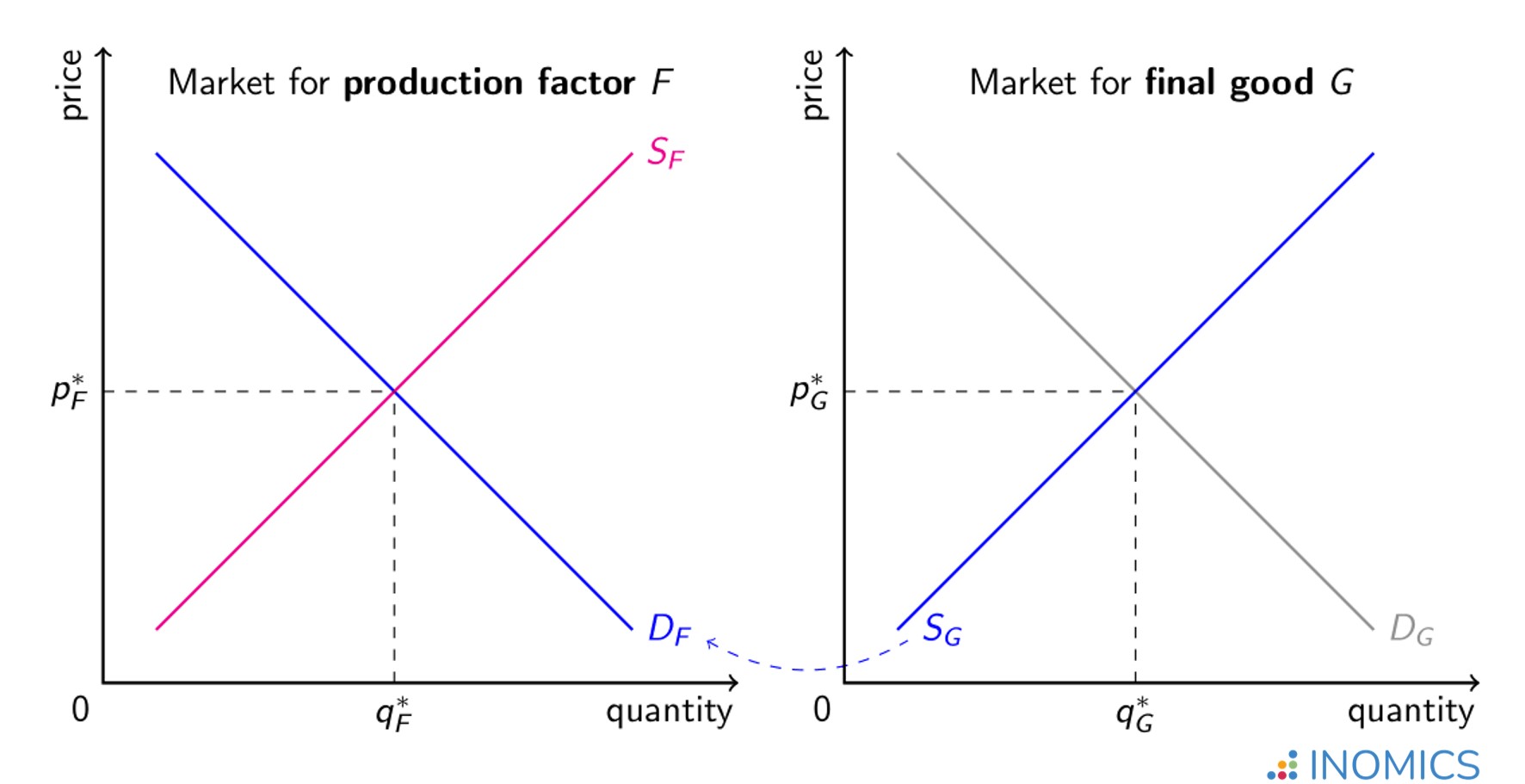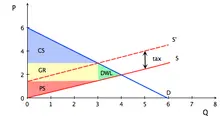Economics Terms A-Z
Factor Markets
Read a summary or generate practice questions using the INOMICS AI tool
Factor markets (or resource markets) are markets that help connect buyers and sellers of the inputs used to produce goods and services. “Factors”, then, are inputs used in production, often natural resources or intermediary products that are needed to make more complex goods, like nails or computer chips.
A producer is typically a seller in the market for a final good or service (supply SG in the graph below). Simultaneously, these producers are also buyers in the markets for the factors of production (demand DF below) that they use in their production processes. For example, a paper manufacturer is a seller in the market for paper while being a buyer in the market for wood pulp.

Figure 1: Illustration of factor markets for a firm producing final good G
Figure 1 depicts how markets are often interlinked with one another. For example, the market for cars depends on the markets for raw materials such as steel, rubber and glass. It also hinges on labor markets for people to design and assemble the cars. That’s because these factors are all inputs to production for car producers, who depend on the markets for steel, rubber, glass, laborers, etc. to help them build and sell cars.
Therefore, what is happening in one market can have a “ripple effect” on surrounding markets. If the price of steel increases, car producers face higher costs to produce the same products. This will cause them either to reduce the supply of cars, or to increase their price.
Similarly, if the price of fuel increases, demand for cars will fall due to cross elasticity of demand. This will result in declining demand for steel, rubber, and other inputs by car producers, as they produce fewer cars in response to the lowered demand for cars.
When deciding how much of a production factor to employ, producers weigh its marginal cost (MC) against its marginal revenue product (MRP). MC is derived from prices in the factor market. MRP depends on the market for the final product. As long as the last unit of input adds more to revenue than it does to cost (MRP > MC), it still makes economic sense to use it.
If there were perfect competition in all markets, then the effects of a supply or demand shock from one market onto another’s prices would be relatively easy to calculate. However, in reality, most markets exist in some state of imperfect competition. This means that power is not equally balanced between buyers and sellers.
For example, the labor market is a factor market where prices (i.e. wages) are often affected by collective bargaining through trade unions. It could also be influenced by a government’s decision to implement a minimum wage or some other regulation. Producers can then find themselves squeezed between a high degree of competition in the markets for their final products and high or inflexible costs in their factor markets.
Interdependencies between factor and product markets sometimes provide good reason for producers to buy out their input suppliers, merging along the supply chain (so-called vertical integration). For instance, if a car manufacturer purchases the firm they buy steel from, they would be vertically integrating. In effect, sales contracts are then replaced by employment contracts and free, internal transactions between departments. This helps a business reduce transaction costs when acquiring inputs, and gain a higher degree of control over the production process.
While such changes in ownership structure can help producers to control risk and increase efficiency, they also tend to reduce competition. This can lead to market failure and issues of antitrust.
The major factors of production in an economy
So far in this article, we’ve discussed factors from the perspective of firms selling final goods. But, there are a few other major factors of production to discuss: land, labor, capital, and entrepreneurship.
These four factors of production aren’t always bought and sold like typical factor inputs, yet they are all considered inputs to production. Land as a factor is bought and sold much the same way as other factors, but it is unique in that there is a finite amount of land to share between everyone.
Labor has already been alluded to. The labor market is the factor market for labor, where skilled workers vie for employment as a valuable input for an employer’s business. Labor is usually accounted for in the basic Cobb-Douglas model of production by the variable L.
Capital itself is also a factor of production. Capital as a factor includes inputs such as manufacturing machines and other tools and equipment. It also includes financial capital that businesses use to operate, and human capital, a very important input that is developed by education and on-the-job training. Capital is represented in the basic Cobb-Douglas model of production by the variable K.
Entrepreneurship is not always pointed out as a factor of production, but some economists mention it because it is the ingenuity that helps foster economic growth. Entrepreneurs combine inputs in new ways, develop more efficient and productive economic processes, and launch entirely new ventures that can disrupt industries and lead to creative destruction.
Further reading
John Dunlop and Benjamin Higgins discuss how different forms of competition in factor markets can affect wages and prices across the economy. They use a general-equilibrium approach in their early paper, “‘Bargaining Power’ and Market Structures” (Journal of Political Economy, 1942).
Good to know
A sound understanding of factor markets is imperative for making successful investments in the stock market. When assessing a firm’s future potential it is important not just to consider direct competition in its final product market but also to look at the trends in its factor markets and their effects on its future performance. For example, if the price of jet fuel rises, ceteris paribus one would expect airlines' financial performances to decline. Generally speaking, the higher the degree of competition in factor markets and the lower the degree of competition in the final-product market, the higher the value of a final producer.
-
- PhD Candidate Job
- Posted 2 weeks ago
Fully Funded PhD Positions in Economics, University of Lugano (USI), Switzerland
At Università della Svizzera italiana (University of Lugano) in Lugano, Switzerland
-
- Conference
- Posted 2 weeks ago
EcoMod2026 International Conference on Economic Modeling and Data Science
Between 8 Jul and 10 Jul in Esch-sur-Alzette, Luxembourg
-
- Workshop, Conference
- Posted 1 week ago
Venice Summer Institute
Between 22 Jun and 25 Jun in Venice, Italy and Venice, Italy












